Built by and for the German Community
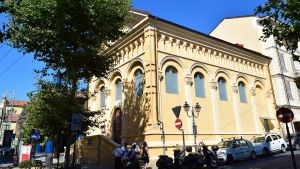 Situated in Corso Garibaldi next to the former flower market, the sacred building was built in 1882 to a design by the architect Giacomo Pisani, who had been commissioned by the local German community, who had also received a financial contribution from the German Emperor William I.
Situated in Corso Garibaldi next to the former flower market, the sacred building was built in 1882 to a design by the architect Giacomo Pisani, who had been commissioned by the local German community, who had also received a financial contribution from the German Emperor William I. 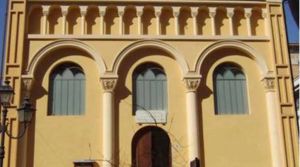 The church, characterized in its architectural structure by a style that unites Gothic and Romanesque elements, was intended for the religious needs of the many tourists from Germany who were guests of our city.
The church, characterized in its architectural structure by a style that unites Gothic and Romanesque elements, was intended for the religious needs of the many tourists from Germany who were guests of our city.
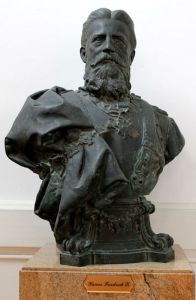 The interior houses, among other things, a bronze bust of Crown Prince Frederick William of Germany and a framed panel in remembrance of his participation in the
The interior houses, among other things, a bronze bust of Crown Prince Frederick William of Germany and a framed panel in remembrance of his participation in the 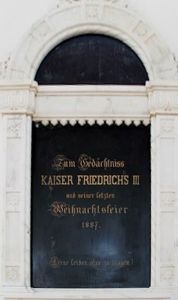 Mass of Christmas on 25 December 1887 .
Mass of Christmas on 25 December 1887 .
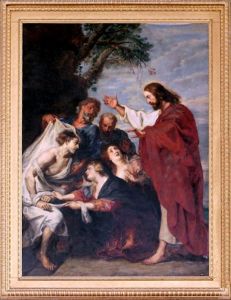
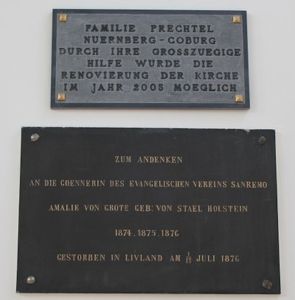 Behind the altar a copy of the Resurrection of Lazarus by Pieter Paul Rubens. A plaque commemorating Countess Amelia von Stael Holstein, who carried out intensive charitable work in San Remo between 1874 and 1876.
Behind the altar a copy of the Resurrection of Lazarus by Pieter Paul Rubens. A plaque commemorating Countess Amelia von Stael Holstein, who carried out intensive charitable work in San Remo between 1874 and 1876.
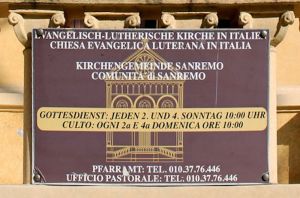 After the Second World War, during which the apse of the building was destroyed by bombing, the church was reopened for worship by the local Lutheran Evangelical community.
After the Second World War, during which the apse of the building was destroyed by bombing, the church was reopened for worship by the local Lutheran Evangelical community.
The structure has been recently restored and renovated.
Story : How it all began ...
Lady Kay Shuttleworth, English, was very attached to the German Evangelical Church and had a great sympathy for Germany. As a girl she already had a photo and some books about Martin Luther.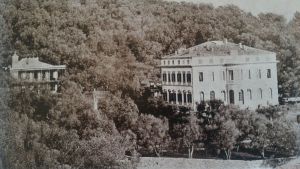 In 1868 she spent the winter months in the then not well known Sanremo. It was only supposed to be a modest flat but in the end it was a large mansion "Villa Ponente" and today called "Villa Quisisana", in Via Hope 1.
In 1868 she spent the winter months in the then not well known Sanremo. It was only supposed to be a modest flat but in the end it was a large mansion "Villa Ponente" and today called "Villa Quisisana", in Via Hope 1.
They were big rooms, everything was much bigger than he wanted. He had servants from Italy and Germany.
Lady Shuttleworth was very socially involved from the beginning and took care of the German orphans who lived here temporarily. Pastor Paul Bennemann from Halle, who ran a school in Bordighera, was allowed to preach for this small domestic community on Sundays.
Bennemann had offered to officiate Easter in the villa in 1870.
Lady Shuttleworth was often asked by German gentlemen who lived regularly in San Remo if they could come to their villa for this special event. So the idea of making regular church services accessible to all souls made sense, and so on Easter Monday, 18 April 1870, the first German community service was held in Lady Shuttleworth's villa in San Remo. From now on, regular public services were held in the villa and the hall was filled until the last session by the winter of 1870/1871.
Lady Shuttleworth died in Bad Soden im Taunus on 14th September 1874, but her thoughts and actions for the German community in Sanremo remained present. 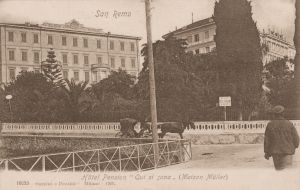 The following autumn the lawyer Dr. Rose from Hanover, who had moved here for health reasons, took a kind of pension in the villa. However, he allowed the free extension of the hall for the Christian community and also provided them with a book of harmonium and hymns.
The following autumn the lawyer Dr. Rose from Hanover, who had moved here for health reasons, took a kind of pension in the villa. However, he allowed the free extension of the hall for the Christian community and also provided them with a book of harmonium and hymns.
In 1873, Pastor Mader founded a committee for church affairs and invited the population to support the congregation with donations. The proceeds from the collections, organised by a women's committee and with the support of von Grote, made it possible to realise the church on 8 December 1874.
In the meantime, some English people had joined the community and financially supported the association. Markets and other collections were held, which now took place in German and English. In the autumn of 1874 it was decided that the meeting of the English Church had been expressly authorised.
But the hall of the villa quickly became too small for the growing community. Now they wanted their adoration space.
After long negotiations with the town administration, the association was equipped with an ancient Catholic chapel in Piazza Cassini. It was agreed that an annual donation of 100 lire should be paid to the town as a "small recognition" for this kind courtesy.
People moved to this place of worship, but the growing noise of the city traffic had made it almost impossible to celebrate a peaceful service. 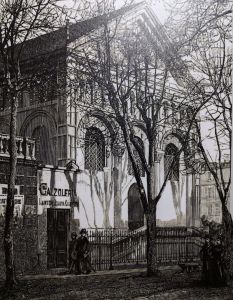 In 1880, thanks to the numerous donations, collections and market proceeds, an impressive sum of 21,500 lire was accumulated and the decision was made to build a church on their own.
In 1880, thanks to the numerous donations, collections and market proceeds, an impressive sum of 21,500 lire was accumulated and the decision was made to build a church on their own.
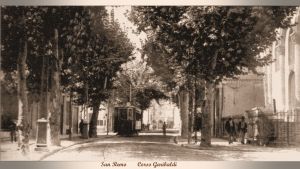 A building site was purchased and started on Corso Garibaldi and the small church, built to a design by the architect Pisani, was inaugurated on 22nd January 1882. The total cost was 39,791 lire, supported by further generous donations. One of the patrons was, for example, the Crown Prince Federico Guglielmo who became, though for a short time, His Majesty "Kaiser Wilhelm I", who donated 3,000 lire.
A building site was purchased and started on Corso Garibaldi and the small church, built to a design by the architect Pisani, was inaugurated on 22nd January 1882. The total cost was 39,791 lire, supported by further generous donations. One of the patrons was, for example, the Crown Prince Federico Guglielmo who became, though for a short time, His Majesty "Kaiser Wilhelm I", who donated 3,000 lire.
(source: from a German-language site " IMPERIA - Historische Reise durch die Provinz " "Viaggio storico attraverso la Provincia", ©by Dora Cacciatore 2015; images from Private Archives and the Web)




